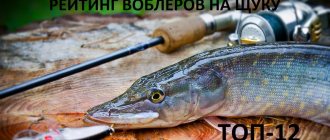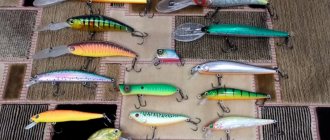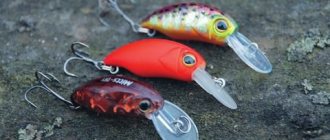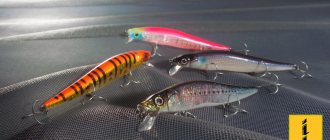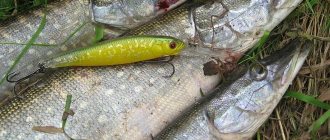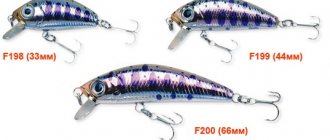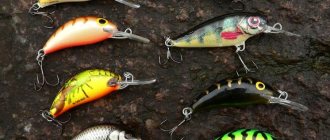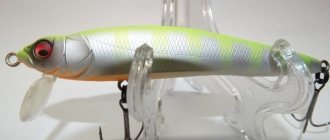Wobblers for twitching
In 2014, I became seriously interested in fishing with wobblers; I devoted about half of the fishing trips of the 2014 season to them. And I have my own “favorites” that I want to tell you about.
I would also like to note that I began to master fishing with wobblers when I switched to fishing with multiplier gear. And this is not just so, it is when fishing with a multi that the angler has a number of advantages when working with this type of bait, especially when using jerking (twitching).
And so here is my “unstoppable seven”.
Jackall Tiny Magallon SP\SR. (8.8 cm, 7.2 g)
This wobbler doesn’t need much introduction. He has long won the hearts of many fishermen and my heart was no exception. In common people it is better known as “tinik”. In the 2014 season, the Jackall Tiny Magallon became my favorite wobbler. More pike of various sizes have been caught with it, and medium-sized perch are also often caught with tinik.
A special feature of the wiring is a long pause; it is this that provokes the most passive predator to attack. Most often, I used this wobbler in shallow water areas, near reed thickets, at medium distances, since the wobbler is an articulated wobbler, and casting range for the wobblers is not their strong point. When purchasing the Jackall Tiny Magallon, I had high hopes for this wobbler and they were justified to an even greater extent.
Pike caught on a Jackall Tiny Magallon wobbler
Jackall Tiny Magallon
Jackall Tiny Magallon beaten by pike attacks
Little secrets of Twitch
In places where the predator sticks to the bottom, but you don’t want to cling to the bottom, it’s worth using a suspender with an enlarged blade. By driving it to depth, you can stop it there and provoke it to attack a passive predator. More often than not, this technique works for perch. When loading the bait with a steel or vole leash, do not forget to remove the winding ring.
Having mastered twitching fishing with branded wobblers that you are confident in, you can switch to twitching with cheaper and more accessible Chinese wobblers. In the large assortment under heaven you can find a truly very catchy wobbler.
Zip Baits Orbit 80 SP\SR. (8 cm., 8.5 g.)
Orbit is an excellent wobbler-searcher for active pike. Excellent for high-speed fishing of large water areas.
It is distinguished by accuracy and casting range, and this is the merit of the patented Zip Baits - Mag-Drive system.
It often helps out in situations where you need an accurate cast to the place where the pike “splash”. Orbit works just as well on passive fish, you just need to slow down the retrieve.
There is also a deep-sea model Zip Baits Orbit 80 SP\DR in use, but it was not possible to achieve much success with it. I consider this wobbler number one in water bodies with a depth of up to 2-2.5 meters for small and medium-sized pike. The Orbit 80 somehow didn’t work out well with perch; I didn’t catch a single one throughout the entire season.
Even such a pike does not miss Zip Baits Orbit
Smith Jib 90 F. (9 cm, 6.7 g)
King of shallow waters in distant areas. A wonderful wobbler with an unusual body geometry. A distinctive feature is its rapid ascent to the surface of the water, which introduces a number of features into its wiring.
It is thanks to its “active” ascent that the Smith Jib 90 F can be carried out in the shallowest areas of reservoirs. And it is the full ascent of the wobbler to the surface that often provokes the predator to attack.
This wobbler is perfect for high-speed fishing in shallow water areas.
Excellent casting range is another important advantage of the Jib. When I first used Jib, I was surprised by one of its features - active native play. It would seem, how can a wobbler with such a small blade have its own pronounced game? But no, she is. Therefore, it can be driven by stop&go wiring, but I prefer twitching.
Pike caught on Smith Jib
Smith Jib
Types of twitching and postings
There are three basic options for twitching wiring. Let's take a closer look at them.
Monotonous
This type of fishing shows good results when catching a striped predator - perch. It can be effectively used for active fish, “boilerfish”, and when catching rare specimens.
Important! The success of twitching fishing depends on the correct technique: the more passive the behavior of the predator, the sharper and more impulsive the movements of the rod should be.
Most often, this type of twitching wiring is acceptable for “minnow” class baits, but quite decent results are obtained when using “deep” class wobblers.
To twitch correctly, you need to:
- Throw the gear into a promising place.
- Wind excess line onto the reel.
- Place the tip of the rod near the water and place the free line on its surface.
- Without using the reel, jerk the line to the side. The result should be a jerk of the bait to the side, but no pulling.
- Hold the reel handle with your other hand and reel in the excess line.
- Continuing jerking, unwind the thread. The actions must be performed alternately, the wobbler is driven by sharp jerks with the rod, maintaining an amplitude of movements of 40 cm.
When retrieving monotonously, the rule applies: the further the cast, the sharper the jerk. This point must be taken into account when using soft types of threads, as well as when equipping the tackle with large wobblers. The optimal speed for baiting is 2 jerks per second. Here the wobbler should not be allowed to show its game; it should move exclusively to the sides.
Rhythmic
A distinctive feature of this type of wiring is the execution of a series of jerks without pauses. After which a stop is made, and the series of twitching wobblers resumes again. The fisherman himself adjusts the number of movements and the duration of the pause, taking into account the activity and fishing conditions.
Chaotic
Wiring shows its effectiveness in catching toothy beasts, especially in combination with pike baits. Due to its design features, the wobbler is able to make a greater number of jerking movements and quickly attract the attention of fish.
In principle, there are no significant differences from the previous method of fishing, with the exception of one point - each new jerk is made with increasing force. At the same time, the duration of the pause also changes. This technique allows you to create chaotic behavior of the bait, the main thing is that the fishing rod has a fast action with a soft whip. This type of wiring is also called classic twitching.
Jackall Squad Minnow 65. (6.5 cm, 5.8 g)
The smallest representative from the Squad Minnow series from Jackall. A “well-fed” mina with a pronounced personal game. Quite stubborn for its size.
When retrieving, he loves short jerks, a series of such short jerks, as well as pumping pulls. Not large pike, but also perch respond well to the Squad Minnow 65.
Perhaps when fishing for perch, the coloring of the model I had - “perch-like” - played a role here, although this is just a guess.
The Squad Minnow often saved lives in conditions where the fish refused to take larger baits, namely, it was actively attacked.
Alexey and his trophy, taken on Jackall Squad Minnow 65
Pike on Jackall Squad Minnow
Megabass FX9. (9 cm., 10.5 g.)
One of the few representatives of Megabass wobblers in my collection. I purchased this wobbler in the fall. It would seem that the pike had already begun to move to deeper parts of the reservoir, but despite this, the FX 9 did an excellent job of collecting the last pike in the shallows.
One of the features is a folding blade, which, when casting under air resistance, is pressed against the body of the bait, which has a good effect on the casting distance.
In its play, the wobbler is similar to the Smith Jib 90 F, but has a lower ascent speed and a more sweeping twitching game. Another feature is the wobbler tees - they are quite powerful and have an “external sting”, so when fishing, the number of trips is minimal. It will be possible to fully open the wobbler only in the 2015 season, but there are already some positive impressions left.
Autumn pike caught on Megabass FX9
Zip Baits Rigge 70 F\SR. (7 cm., 4.7 g.)
I bought this wobbler thanks to many flattering reviews about it and did not regret it. Rigge has proven itself well when fishing for pike in hot weather, when you need a compact bait in shallow water. Both pike and perch responded well to it.
Just like the Zip Baits Orbit, the Mag-drive long-distance casting system is used here, therefore, there are no problems with accuracy and range. When wiring, I most often used single jerks, during which the wobbler made turns. I also most often use the Rigge 70 in “perch boilers”, I don’t know why, but its performance in the “boiler” is higher than with other wobblers.
How to catch pike using twitching.
It has long been no secret that fishing for pike by twitching is considered the most effective way of catching pike, especially in the spring, but only in those places where it is permitted.
The essence of fishing by twitching is that the movements of the wobbler in the water column are sweeping and chaotic and thereby provoke the pike to attack.
It is also worth noting that twitching can be different, it all depends primarily on the fisherman, in this case, some develop habits when fishing for pike, that is, a certain style, but it is also worth accepting the fact that changes will not hurt, but maybe on the contrary they can be useful.
Basically, twitching can be divided into active and passive wiring of a wobbler. What is the meaning of active twitching, and the whole point is that activity implies continuous jerking of the wobbler.
And the passive style of wiring is slightly different from the active style in that the wiring is made smoother, that is, after jerking, there is a pause of several seconds, depending on the wobbler, it can be sinking or floating, as well as on the fishing location. When twitching, wobblers of the MINNOW class have proven themselves very well; the pike really liked the large wobblers and it cannot leave them without attention.
Features of pike fishing.
All fishermen have long known that pike give their preference to those places where there is something to eat, namely small fish, and small fish, as is already known, feed closer to the shore or generally in shallow water near aquatic vegetation, and that’s where the pike sits in ambush.
The result is the fact that when choosing a place for an ambush, the pike does not fully understand that it is exposing itself to danger or, more simply put, can be easily caught by an angler.
And then everything becomes more interesting, namely, that the so-called ambush places are not very deep and are clearly visible, and in this type of fishing we only need this, since control of the wobbler occurs in the angler’s field of vision, when choosing one or another tactic wiring, you can watch in despair what happens to the bait and how the pike attacks, which is also not unimportant, namely after the attack the hooking occurs and here, as if you need to contemplate all this action, so as not to be disappointed in the loss of the expected trophy.
But do not forget that silence should accompany the fisherman, since the pike may get scared and leave the place where, by all indications, it should be waiting.
The basic rule of twitching.
After casting the bait to the desired location, a couple of jerks are made with a spinning rod, in parallel with the jerks, the reel handle is turned, thereby adjusting to the slack of the fishing line.
And all these actions are repeated after some breaks. It is worth noting that the twitching process involves small amplitudes of movement of the tip of the spinning rod. After several casts, the angler develops his own individual twitching fishing technique.
And here, too, you should not forget about the place of fishing and the reservoir, and they can be different, both with and without current, and in this case the wiring may partially differ from each other.
It all depends on the skill of the fisherman; if you don’t have it, then don’t despair, the twitching fishing technique is not that complicated, a couple of casts and you’re already a master. The whole process of fishing using twitching is best done from a watercraft , but it is also possible from the shore.
ribakclub.ru
Pontoon 21 Greedy Guts 77 F\SR (7.7 cm, 9 gr.)
This is one of the last wobblers from Pontoon 21, which I decided to keep in my arsenal. Works well on active medium pike and medium/large perch. Most often I used wiring alternating a series of jerks with a pause. The ascent speed of the wobbler is low, which is something not many floating wobblers with a depth of up to 1-1.2 meters have.
When the wobbler begins to slowly rise in the water column, bites often occur. The wobbler has a good casting range, thanks to its light weight for its size.
Pontoon 21 Greedy Guts 77 in the mouth of a pike
In this article, I tried to most widely reveal the features and wiring of my favorite wobblers for twitching for the spring-autumn season of 2014. You shouldn’t get hung up on one bait and wiring, constantly experiment and you will be happy.
If you have any questions about the kit, or to me personally, please leave them in the comments to the article.
Author: Alexey Spirin (Specially for SpinBait.ru)
Types of wobblers for perch
For a beginner, it is very important to quickly achieve a positive result, because few people will persist in fishing unsuccessfully. And to do this, you need to either study this science on your own, or enlist the help of an experienced spinner. The second is preferable.
What are the main types of wobblers that exist today?
- Shallow - surface, for fishing in shallow water;
- Floating – floating, after the winding stops they float up;
- Suspend - balanced in the water column, having reached the working depth, they do not sink or float even if the wiring stops;
- Sinking - drowning;
- Deep - deep, more suitable for hunting trophy fish at a depth of five meters or more (or for trolling from a boat)
In addition, wobblers differ in shape (their game directly depends on this) and in depth at the time of posting. It cannot be categorically stated that one or another configuration is more suitable for catching a certain type of predator. It is much more important to assemble the fishing tackle correctly, in other words, to coordinate the spinning test, the size of the reel and the weight of the bait. Otherwise, you risk, if not breaking the rod, then not reaching a promising place. I don’t even want to talk about a cheap, low-quality reel; it can both ruin fishing and discourage fishing in general.

